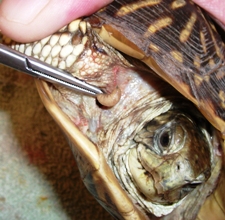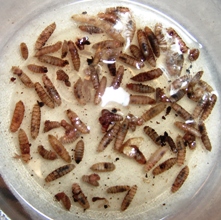Box Turtles: Common Problems
Box turtles are hardy and long-lived if cared for properly.
A common mistake is feeding a diet too low in vitamin A, calcium, or other nutrients. Depending on the nutrients that are missing, a malnourished box turtle will suffer from dry flakey skin, overgrown beak and toenails, and deformed shells. Once affected, some box turtles may require special calcium supplements, injections of vitamin A, special diets, and assist-feeding until they are doing well.

This female box turtle has a mildly overgrown beak and very dry flakey skin. She did not have enough protein or vitamin A in her diet. There is a good chance all of her issues will resolve once she is on a good diet.
This box turtle has swollen eyelids, a sign of vitamin A deficiency.
This female box turtle has a very overgrown beak, overgrown brittle toenails, and dry flakey skin. Her vitamin A deficiency is much more advanced than the previous box turtle. This beak needs to be groomed by a veterinarian and there is a chance that it may grow back normally once the diet is corrected.
This very ill box turtle has a very overgrown and deformed beak, sometimes called "duck beak", overgrown toenails, and dry flakey skin. It has lost a lot of weight because it can no longer eat on its own. Box turtles that are this badly affected may take a long time to heal, and will always need regular beak groomings by a veterinarian to be able to eat.
Many box turtles are still collected from the wild. You may notice a small hole or multiple holes in the skin on the neck or around the legs. These holes are due to botfly larvae (maggots) which need to be removed by a veterinarian. There can be dozens to hundreds of botfly larvae on a single box turtle. Many box turtles needs antibiotics and other medical care to recover from this infestation.


A botfly larvae is being removed from a wild-caught ornate box turtle. On the right are the dozens of larvae that were removed from this turtle.

